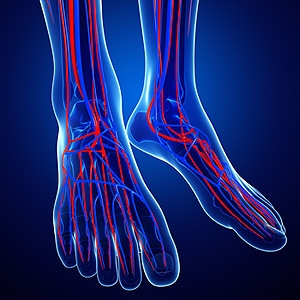
Gout and Diet
 Small urate crystals that can lodge in the joints of the big toe, causing severe pain, can be indicative of gout. Gout is a form of arthritis, and is caused by excess uric acid in the bloodstream. It may develop as a result of genetic factors, or from eating foods that have large amounts of purines. These types of foods can include shellfish, red meat, alcohol, and drinks that are made with sugar. Some of the symptoms that are associated with this ailment consist of pain and swelling in the big toe and surrounding area, and the condition may worsen at night. Patients who have high blood pressure, kidney disease, or who may be obese are more likely to develop gout. Relief may be felt after making positive lifestyle changes, such as dietary modifications that may consist of eating more fruits, vegetables, and drinking plenty of fresh water. If you are afflicted with gout, it is strongly suggested that you are under the care of a podiatrist who can effectively treat this condition.
Small urate crystals that can lodge in the joints of the big toe, causing severe pain, can be indicative of gout. Gout is a form of arthritis, and is caused by excess uric acid in the bloodstream. It may develop as a result of genetic factors, or from eating foods that have large amounts of purines. These types of foods can include shellfish, red meat, alcohol, and drinks that are made with sugar. Some of the symptoms that are associated with this ailment consist of pain and swelling in the big toe and surrounding area, and the condition may worsen at night. Patients who have high blood pressure, kidney disease, or who may be obese are more likely to develop gout. Relief may be felt after making positive lifestyle changes, such as dietary modifications that may consist of eating more fruits, vegetables, and drinking plenty of fresh water. If you are afflicted with gout, it is strongly suggested that you are under the care of a podiatrist who can effectively treat this condition.
Gout is a foot condition that requires certain treatment and care. If you are seeking treatment, contact Dr. Stephen Petrofsky from Florida. Our doctor will treat your foot and ankle needs.
What Is Gout?
Gout is a type of arthritis caused by a buildup of uric acid in the bloodstream. It often develops in the foot, especially the big toe area, although it can manifest in other parts of the body as well. Gout can make walking and standing very painful and is especially common in diabetics and the obese.
People typically get gout because of a poor diet. Genetic predisposition is also a factor. The children of parents who have had gout frequently have a chance of developing it themselves.
Gout can easily be identified by redness and inflammation of the big toe and the surrounding areas of the foot. Other symptoms include extreme fatigue, joint pain, and running high fevers. Sometimes corticosteroid drugs can be prescribed to treat gout, but the best way to combat this disease is to get more exercise and eat a better diet.
If you have any questions please feel free to contact our office located in Port Charlotte, FL . We offer the newest diagnostic and treatment technologies for all your foot and ankle needs.
Gout
Gout is a form of arthritis that is caused by a buildup of uric acid crystals in the joints. This considered to be one of the most frequently recorded medical illnesses throughout history. Gout occurrences in the US have risen within the past twenty years and the condition now affects 8.3 million people which is 4% of all Americans. Researchers have found that gout affects men more than women and African-American men more than white men.
Symptoms of gout are warmth, swelling, discoloration, and tenderness in the affected joint area. The small joint on the big toe is the most common place for a gout attack to occur.
People who are obese, gain weight excessively, drink alcohol heavily, have high blood pressure, or have abnormal kidney function are more likely to develop gout. Furthermore, certain drugs and diseases are likely to increase levels of uric acid in the joints which eventually leads to gout. You are also more likely to develop gout if you eat a lot of meat and fish.
Many who experience gout attacks will experience repeated attacks over the years. Some people who have gout symptoms, may never have them again, but others may experience them several times a year. If you have gout symptoms throughout the year, you may have recurrent gout. Those who have gout should also be careful about their urate crystals collecting in their urinary tract, because this may lead to kidney stones.
Diagnosis for gout is done by checking the level of uric acid in the joints and blood. Your podiatrist may also prescribe medicine to reduce uric acid buildup in the blood, which will help prevent any gout attacks.
To treat gout, your podiatrist may also prescribe you Anti-inflammatory medication (NSAIDs) which will relieve the pain and swelling of a gout episode and it can also shorten a gout attack. Maintaining a healthy diet is also a proven method to prevent gout attacks.
What Bones Can Break In an Ankle Fracture?
 Your ankle is made up of three bones, all of which can be broken or cracked from an injury. The tibia is the larger of two main bones that make up your ankle. You can feel the lower end of it along the inside of your ankle. The fibula is the thinner of the two main ankle bones, and you can feel the lower end of this bone along the outside of your ankle. The talus is a wedge-shaped bone located deep inside the ankle, between the heel bone and the ends of the tibia and fibula. Ankle fractures are usually caused by a sudden, sharp twist of the ankle or a direct impact to the area. Symptoms include immediate, severe pain, swelling, bruising, tenderness, and difficulty walking. If you suspect that you may have fractured your ankle, it is strongly suggested that you seek the care of a podiatrist as soon as possible.
Your ankle is made up of three bones, all of which can be broken or cracked from an injury. The tibia is the larger of two main bones that make up your ankle. You can feel the lower end of it along the inside of your ankle. The fibula is the thinner of the two main ankle bones, and you can feel the lower end of this bone along the outside of your ankle. The talus is a wedge-shaped bone located deep inside the ankle, between the heel bone and the ends of the tibia and fibula. Ankle fractures are usually caused by a sudden, sharp twist of the ankle or a direct impact to the area. Symptoms include immediate, severe pain, swelling, bruising, tenderness, and difficulty walking. If you suspect that you may have fractured your ankle, it is strongly suggested that you seek the care of a podiatrist as soon as possible.
Broken ankles need immediate treatment. If you are seeking treatment, contact Dr. Stephen Petrofsky from Florida. Our doctor can provide the care you need to keep you pain-free and on your feet.
Broken Ankles
A broken ankle is experienced when a person fractures their tibia or fibula in the lower leg and ankle area. Both of these bones are attached at the bottom of the leg and combine to form what we know to be our ankle.
When a physician is referring to a break of the ankle, he or she is usually referring to a break in the area where the tibia and fibula are joined to create our ankle joint. Ankles are more prone to fractures because the ankle is an area that suffers a lot of pressure and stress. There are some obvious signs when a person experiences a fractured ankle, and the following symptoms may be present.
Symptoms of a Fractured Ankle
- Excessive pain when the area is touched or when any pressure is placed on the ankle
- Swelling around the area
- Bruising of the area
- Area appears to be deformed
If you suspect an ankle fracture, it is recommended to seek treatment as soon as possible. The sooner you have your podiatrist diagnose the fracture, the quicker you’ll be on the way towards recovery.
If you have any questions, please feel free to contact our office located in Port Charlotte, FL . We offer the newest diagnostic and treatment technologies for all your foot care needs.
All About Broken Ankle
Broken ankles or “ankle fractures” are injuries that occur when the bones that make up the ankle joint are broken. Ankle injuries are some of the most common bone and joint injuries. The ankle joint is made up of three bones that join. The tibia is the main bone, and it makes up the inside of the anklebone. The fibula is a smaller bone, and it makes up the outside of the anklebone. A membrane called the joint capsule is lined with a layer called the synovium, which covers the entire joint. The synovium produces synovial fluid which allows for the joint surfaces to move.
An ankle becomes broken when the joint is stressed beyond the strength of its limits. When an ankle is fractured, ligaments may also tear at the same time. Fractures often occur to the ankle rolling or twisting in an unusual way. At times, a fracture may even be caused by an extreme force applied to the joint.
Symptoms of a broken ankle include pain, swelling, bruising, discoloration, numbness, and an inability to move the toes. If you have a broken ankle, you may also hear something tear or snap when you initially suffered the injury. If you have pain from a broken ankle, beware that the pain will not always come from the exact area of the fracture; you may also experience pain from associated foot fractures. The swelling you may experience can suggest that soft tissue damage may have occurred due to the injury.
There are differences between an ankle fracture and an ankle sprain. The difference is that a fracture or break in the bone is required to classify an injury as a broken ankle. An ankle sprain occurs when there is a tear or disruption of ligaments in the ankle. In some cases, the prognosis of an ankle sprain may be worse than that of a fracture.
X-rays are the most common way to diagnose a broken ankle. X-rays show if the ankle is broken and where exactly the fracture is located. It will also show how many pieces of broken bone there are. A second method of testing to see if an ankle is broken is a stress test. To do this, the doctor will put pressure on the ankle and perform a stress test to determine if the fracture requires surgery. Other methods for diagnosis include CT scans and MRI scans.
If you are suffering from a broken ankle, consult with your podiatrist immediately to receive a proper diagnosis and treatment.
Who Needs an Ankle-Brachial Index Test?
 The Ankle-Brachial Index (ABI) is a simple, non-invasive screening for peripheral artery disease, an ailment that affects blood flow in the lower limbs. The test consists of having your blood pressure measured at your upper arms and ankles. The doctor then compares the two resulting numbers to come up with a ratio that correlates to risk of having peripheral artery disease. Not everyone needs an ABI. It is usually reserved for patients who are most at risk of developing this condition. This includes people who are older, have high blood pressure, high cholesterol, diabetes, atherosclerosis, a history of smoking, or symptoms of peripheral artery disease, such as leg pain, cramping, weakness, numbness, or difficulty walking. If you have any of these risk factors, it is suggested that you see a podiatrist for an ABI test.
The Ankle-Brachial Index (ABI) is a simple, non-invasive screening for peripheral artery disease, an ailment that affects blood flow in the lower limbs. The test consists of having your blood pressure measured at your upper arms and ankles. The doctor then compares the two resulting numbers to come up with a ratio that correlates to risk of having peripheral artery disease. Not everyone needs an ABI. It is usually reserved for patients who are most at risk of developing this condition. This includes people who are older, have high blood pressure, high cholesterol, diabetes, atherosclerosis, a history of smoking, or symptoms of peripheral artery disease, such as leg pain, cramping, weakness, numbness, or difficulty walking. If you have any of these risk factors, it is suggested that you see a podiatrist for an ABI test.
Vascular testing plays an important part in diagnosing disease like peripheral artery disease. If you have symptoms of peripheral artery disease, or diabetes, consult with Dr. Stephen Petrofsky from Florida. Our doctor will assess your condition and provide you with quality foot and ankle treatment.
What Is Vascular Testing?
Vascular testing checks for how well blood circulation is in the veins and arteries. This is most often done to determine and treat a patient for peripheral artery disease (PAD), stroke, and aneurysms. Podiatrists utilize vascular testing when a patient has symptoms of PAD or if they believe they might. If a patient has diabetes, a podiatrist may determine a vascular test to be prudent to check for poor blood circulation.
How Is it Conducted?
Most forms of vascular testing are non-invasive. Podiatrists will first conduct a visual inspection for any wounds, discoloration, and any abnormal signs prior to a vascular test.
The most common tests include:
- Ankle-Brachial Index (ABI) examination
- Doppler examination
- Pedal pulses
These tests are safe, painless, and easy to do. Once finished, the podiatrist can then provide a diagnosis and the best course for treatment.
If you have any questions, please feel free to contact our office located in Port Charlotte, FL . We offer the newest diagnostic and treatment technologies for all your foot care needs.
Vascular Testing in Podiatry
In foot care, vascular testing may be required in the diagnosing and treatment of certain podiatric conditions. Vascular testing is particularly relevant for patients with high-risk diabetes, poor circulation, peripheral artery disease (PAD), and chronic venous insufficiency (CVI). Procedures typically involve the examination of blood vessels throughout the body for blockages or buildup.
Vascular testing is very important for the diagnosis of various conditions, including peripheral artery disease and chronic venous insufficiency, as these conditions can greatly affect one’s quality of life and cause pain in the lower limbs. Circulatory problems in the feet and ankles can reflect issues throughout the body, making testing of the blood vessels pertinent.
Testing methods vary between practitioners and can be specific to certain foot and ankle problems. Modern technology has brought about the ability to perform vascular testing using non-invasive methods, such as the cuff-based PADnet testing device. This device records the Ankle-Brachial Index (ABI)/Toe-Brachial Index (TBI) values and Pulse Volume Recording (PVR) waveforms. Contact your podiatrist to determine what vascular testing is available for your needs.
My Child's Foot Is Asleep
Foot numbness in children is frequently caused by a compression of the nerves in the foot following a period of sitting with the legs or feet tucked underneath the body. The term for this is the foot “falling asleep.” Though your child may feel a pins and needles sensation, heaviness, or pain in their feet upon standing, this is nothing to worry about and tends to go away within minutes as the foot “wakes up.” Nevertheless, there are other possible causes of foot numbness, such as injuries to the feet or ankles, that you should watch out for. If your child complains of frequent foot pain or numbness that interferes with their daily activities or gets worse over time, it is suggested that you take your child to see a podiatrist.
The health of a child’s feet is vital to their overall well-being. If you have any questions regarding foot health, contact Dr. Stephen Petrofsky of Florida. Our doctor can provide the care you need to keep you pain-free and on your feet.
Tips for Keeping Children's Feet Healthy
- Make sure their shoes fit properly
- Look for any signs of in-toeing or out-toeing
- Check to see if they have Clubfoot (condition that affects your child’s foot and ankle, twisting the heel and toes inward) which is one of the most common nonmajor birth defects.
- Lightly cover your baby’s feet (Tight covers may keep your baby from moving their feet freely, and could prevent normal development)
- Allow your toddler to go shoeless (Shoes can be restricting for a young child’s foot)
- Cut toenails straight across to avoid ingrown toenails
- Keep your child’s foot clean and dry
- Cover cuts and scrapes. Wash any scratches with soap and water and cover them with a bandage until they’ve healed.
If you have any questions, please feel free to contact our office located in Port Charlotte, FL . We offer the newest diagnostic and treatment technologies for all your foot care needs.
How to Care for Your Child's Feet
It is never normal for a child to experience pain in his or her feet. Foot pain that lasts more than a few days and limits a child’s ability to walk should be examined by a podiatrist. Many adult foot ailments originate in childhood and may be present at birth. Common foot issues that are experienced by children are pediatric flat foot, Sever’s disease, ingrown toenails, and plantar warts.
A child’s foot grows rapidly during the first year, allowing it to reach almost half of their adult foot size. Consequently, foot specialists consider the first year to be the most crucial point in the foot development process. There are ways you can help ensure that your child’s foot develops properly. One way is to carefully look at your baby’s feet. If you notice any deformities, you should immediately seek professional care. You should also loosely cover your child’s foot, since tight coverings may prevent movement and inhibit normal development. Another tip is to change the baby’s positioning throughout the day. If your baby lies down in one spot for too long, it may put an excess amount of strain on the feet and legs.
It is best that you try not to force a child to start walking. Children will begin to walk when they are both physically and emotionally capable to do so. You should also avoid comparing your child’s walking progress with other children because the age range for independent walking may range. When your child’s feet begin to develop, you may need to change both their shoe and sock size every few months to allow room for their feet to grow.
Kids are sometimes prone to splinters, cuts, and severe injuries because they tend to walk around barefoot. This also makes them more susceptible to developing plantar warts which is a condition caused by a virus that invades the sole of the foot through breaks in the skin. These ailments can be avoided by making sure your child wears shoes in unsanitary environments. You should also wash any minor cuts or scrapes on your child’s feet. It is a myth that exposure to fresh air will heal injuries; fresh air will only expose your child’s cuts to germs.
As a parent, you should ensure that your child’s feet are developing properly and are being properly maintained. Consequently, it is important that you perform routine inspections on his or her feet to detect any injuries or deformities in their early stages. Early detection and treatment will help to ensure that your child does not develop any serious foot conditions.

















